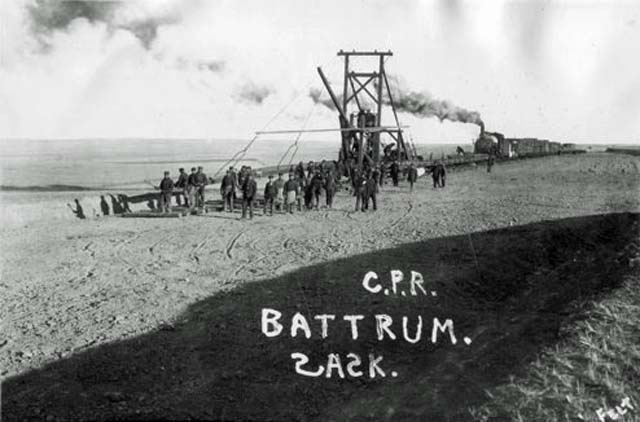
2012
|


Construction of the CPR "Empress Line" northwest of Swift Current - circa 1911 Photographer unknown -
Saskatchewan Archives Board R-A16847.
27 September 2012
Railway Line an Important Part of Swift Current History
Swift Current Saskatchewan - The history of the Canadian Pacific Railway (CPR) in Swift Current and the southwest was highlighted
during a 12 Sep 2012 "Lunch and Learn Talk" by Stephanie Kaduck at the Swift Current Museum.
Kaduck, who is the museum's education and public programs co-ordinator, used historical photos from their own collection to illustrate the contribution of
railway development to the town and region.
Buddy McEwan, who worked as a checker for CPR, was present to add some interesting insights to her presentation.
The transcontinental railway line reached what is now called Swift Current in late 1882.
The area next to the Swift Current Creek was well situated.
"Swift Current was chosen as a division point because we had water and steam engines need water," Kaduck said.
"It was halfway between Moose Jaw and Medicine Hat, so it was a perfect location."
The area benefited from a decision to run the transcontinental railway line along a southern route instead of northwards past the town of Battleford, which was
then the capital of the Northwest Territories that included Saskatchewan.
It was decided a railway line near the southern border with the United States would help to establish Canadian control over the area.
John Macoun's survey of the region during a time of high rainfall resulted in optimistic views about the area's agricultural potential.
While land around Battleford was already owned, there was still land available in the southwest to provide the Dominion government and CPR with profit
opportunities.
"The CPR actually spent more than the Dominion government in promoting the region," Kaduck said.
"They had special exhibition trains that travelled in eastern Canada that had grain samples, photographs, and lots of propaganda."
Swift Current was the most western railway point by 1883 with a lot of trading business going west from there.
The winter of 1883 was cold and there was a fuel shortage.
"One of the trains ended up burning the newly-built platform to get back to Regina for the winter," she said.
Construction work during 1883 included a freight shed, water tank, section house, bunk house, small depot, and a dining hall with 24 rooms above.
The early dining hall served as restaurant, hotel, public meeting house, a makeshift church, and a general gathering place.
One of the early structures was a distinctive railroad roundhouse where locomotives were serviced and rolling stock was turned around.
It was demolished in the 1970s.
By 1884, there were two mixed trains per week and by 1889 there was daily service, which was a great benefit to local businesses.
In 1888, the CPR built a dam, which is now a municipal heritage property located at Riverside Park.
The approximately 139-metre long structure was built with earth, stone, and plank.
"Sometimes the creek would get down to just a trickle and so by establishing this dam they had a consistent source of water," she said.
They built a pump house at the dam and underground pipes fed the water from the dam to the water tank, which was located next to the roundhouse.
CPR also installed a town pump.
"That provided the community with a consistent water source but it did take away one of the jobs that local First Nations had, which was hauling water to
community residents," she said.
The trade in buffalo bones was one of the earliest local industries.
First Nation and Metis people collected buffalo bones on the prairie and sold it to local stores.
The piles of bones were sent eastwards by train, particularly to the northeast United States.
"The very best buffalo bones were used to make bone china and the mid-grade buffalo bones were use to make fertilizer," Kaduck said.
"The ones that have been on the prairie the longest and had most of the oil leached out of them, were used in the processing of sugar."
The railway line was useful for transporting cattle and horses from the United States, as well as plains bison that were purchased by the Canadian government
from two Montana ranchers in 1907.
These animals became the founding herd for all plains bison conservation herds in Canada.
Silk trains travelled through Swift Current until the 1940s, when the CPR transported raw silk from Vancouver to mills in the eastern United States.
These trains travelled fast and had the right-of-way over other trains, including passenger trains and the Royal train.
"The only people that rode the silk trains were guards because these would hold more than $1 million worth of silk," she said.
"The cars were completely sealed, lined with wood that was varnished and then papered to keep moisture, insects, and heat out."
Before private vehicle ownership became more common, trains were an important mode of travel.
There were sometimes special trains from smaller towns such as Success or Stewart Valley to Swift Current.
"It would be like a Saturday shopping trip train," she said.
"Curling was a really big deal and the people would bring their rocks on the train and travel to different communities to have bonspiels."
Along with more vehicles on the road came a reduction in train service until there were eventually no passenger service.
"But the CPR remained very important not only as a feature of the town but as a contributor to its growth and development," Kaduck concluded.
The Swift Current Museum's next lunch and learn talk on 10 Oct 2012 by Rachel Wormsbecher will highlight the history of the city's south side.
Matthew Liebenberg.

|


|
Vancouver Island
British Columbia
Canada
|
|


